 |
 |
Lee Holman VolvoGirl@vclassics.com
Seemed like there was no lack of things to do around there on a rainy day. I was still in awe of David's array of unusual and interesting items, and learning my way around the shop. There was a list of things I wanted to see, and, looking up at the steel pallet racks that form the interior walls of the shop, I knew there was more than I would ever see in the few days I was there. That evening, Robin, David and I went for a swift ride up to Elkhart Lake to get a bite to eat at the Osthoff, where there was a welcome reception for the SVRA. We ended up at Siebken's Resort, an interesting place that is as steeped in race history as the town of Elkhart Lake itself. The tavern we were in was full of life, the air was buzzing with talk of cars and drivers, and the walls and ceiling were festooned with racing memorabilia. While we were there, we ran into Burt Levy, who writes about cars and vintage racing for various car magazines. Also the author of the acclaimed novel The Last Open Road, he was promoting his newest book the long-awaited sequel the soon-to-be-published Montezuma's Ferrari. Using a unique approach to publishing his new novel, he was selling advertising space in the book. This was pre-release, but copies are available now. What a guy! He already rates as one of my heroes. Saturday's weather was better. We put the break in the clouds to good use and spent some time in the yard moving cars so that we could get at the 1800 that was the intended donor for our engine swap project. It was a dark green 1967 1800 that had seen better days. Almost nothing was left of what were once the floor pans, and even the doors had become hard to open thanks to rust and decay. Under the hood, things looked pretty crusty, but the motor had been put away with a dollop of oil in each cylinder, so it turned over with no problem. The car's salient feature now was that it had a strong engine when it was parked a few years back. David's Volvo Garten is as organized as any I have seen. The cars are all parked in neat rows with clear space between them. This was May, when spring was making the world look fresh and green, but before summer's weeds had a chance to get much of a start. The birds were singing, the scent of fresh dirt and flowers was in the air, and I was feeling inspired.
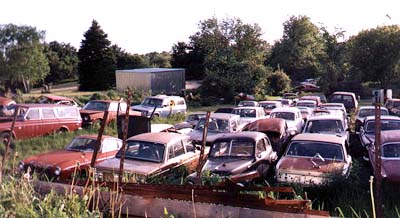 A junkyard in the springtime is a lovely place in my eyes. After the ice and snow of winter have melted away and the cars no longer look like white lumps under a blanket of snow, the old chrome seems to wink at you in the sun, as if the cars want to tell you their stories. At last you can make your way to the cars without a shovel and the parts are warm to the touch. In any case, a new junkyard is always a place of wonder and discovery, so David's yard looked like acres of diamonds to me. We had to move a couple of other cars in the 1800 row to get to our intended victim. Strangely enough, I actually enjoyed crawling under them with the chain to hitch onto the axles so we could haul them out with the tractor (although I would have been happier still if it hadn't rained so recently). We dragged the hapless hulk up to a temporary parking space in front of the garage to make ready for the operation. This engine would be pulled so that we could clean it up, and the sorry donor would soon be pushed aside for the main event. On Sunday, despite the return of rain and wind, David, Hunter and I went to the track to watch the races. We ducked the showers to look under peoples' canopies at their concours-quality vintage racecars and watched some of the feature races from the shelter of David's 242T. Some had a few cars despite the wet track, but many cars never started because of the rain. In Feature Race E, for instance, only two cars started out of thirty-four registered to race, with only one finisher. The next race, Feature Race D, saw nine start and finish out of forty that had been registered to race. It was exciting nonetheless, although five-year-old Hunter grew restless in the car. Luckily, the rain stopped for a spell, so we were able to watch a few laps on the open bleachers at Canada corner before the rain returned with a vengeance and we had to bring Hunter home. The next few days found me pressing on with my priority project as best I could. Once the car had been pushed into the shop, I spent my time preparing to pull the engine to get it ready for its new home. The first afternoon of the project turned into evening and wore on late into the night as I picked off peripheral parts and set them aside. It eventually became clear which of the carbs were the best set and which of the radiators the best bet. The B20 that was in the Jensen had an alternator conversion, and it was decided that this would go onto the new motor. There were a few things that were awkward or difficult. The bolts that held the clutch slave cylinder to the bell housing, for instance, were affected by the all-too-familiar Dissimilar Metals Syndrome (DSM). Fortunately, David seemed happy to help when I needed a hand. It was so pleasant to be working a shop like David's, with his tools so clean and orderly, to the sounds of Mozart on the tape player. A Little Night Music was just the ticket and I kept on into the wee hours. By the time I finally turned in, the engine was ready to come out. The next day, we assembled all hands to pull the motor. It was easy with the use of the hoist, and once it was out, we pushed the sorry old rustbucket back out the door. There was much scraping and cleaning to be done before the motor was ready. The clutch came off as well as the timing gear cover so that new seals could be installed, and we got the block ready for a few coats of shiny red paint. Meanwhile, the transplant patient was rolled in so that we could get the bum engine out of the way and get various parts changed over to the new one. Once the hood was off and the radiator out of the way, I jacked up the front and put it on stands so that I could get a creeper underneath. I wasn't under there for long before I noticed a puddle back by the rear of the car and the unmistakable smell of gasoline. Sure enough, it was weeping from a pinhole in the top of the tank, now that the car was no longer level. It seemed amazing that there was that much fuel in the tank, but then it's a good idea to put a car in storage with a full tank to prevent condensation and water in the tank, so I didn't think that much of it. The immediate solution was to jack up the rear and level the car so it would stop leaking, and we could carry on with our work and leave the tank for later.
Of course, having Robin's mom critically ill was one of those unforeseen problems. While her condition had improved, she was still in intensive care, which meant that Robin had to spend a lot of time at the hospital by her mother's bedside. I carried on in her absence and was grateful for the time we were able to work together. Even when Robin couldn't be there, I was not alone. During the day, Hunter often came by to check on me and I frequently punctuated my work with a quick game of tag that always seemed to end up with the two of us tumbling wildly down the sloping lawn towards the pond. David was largely occupied with his own work, but was nearby in his office. "C'mon in here, I have something to show you..." he would call, or, "There's somebody on the phone you ought to meet..." I was happy to drop what I was doing to look at the things he would dig up to show me. I had always wanted to see a Judson supercharger up close and personal, and was fascinated to meet face to face with so many items that would make most Volvo swap meet fanatics' heads swim. Getting the old engine out of the way posed no special problems. I was glad David was there to tip me off about the bellhousing, because I never would have known that whoever had put the B20 in the Jensen had used the wrong one. The key is using the right one for the block, or you'll run into problems. We used the kind with the block brace. In any case, getting at the upper bolts that secure the bellhousing to the block proved to be a challenge. The motor went in easily enough once it was ready. There were a few problems getting the alternator mounted. Threads had to be chased and the alignment wanted a little adjustment. When were ready to start it, it became apparent that someone had done some creative rewiring, so getting the ignition to fire took some doing. Once we started cranking it, the awful truth about the full fuel tank came to light. The fuel pump wasn't pumping fuel it was water! This, for me, was yet another lesson in the quirks and foibles of the 1800. With the fuel filler door located on the back fender on a more or less horizontal plane, rain will flow in and, if the drain is not clear, the water can pour into the tank. We were beyond the help of a couple of bottles of drygas here. The car had to be pushed out and I rolled underneath on a creeper to drain the tank. More than five gallons of water poured out before the gas started to flow. Once we had fresh fuel, we were able to get the motor started, but it was clear that there would be some more issues to address. The days had rushed by in a blur of activity and there was only one more day before I expected to depart. I had to turn my attention to my own ride to get it ready for the trip home. I wasn't happy about it, but once again we rolled that red 1800 out into the yard, this time into a parking space where it would wait until Robin was free to devote more time to it. Mom was growing stronger every day, so it looked like this could be soon. I had really hoped we would have it on the road while I was there, but it was time to think about moving on.
Now it was time for me to focus on my other main mission at OJR: upgrading my headlamps. David had all the parts in stock, and the next night we worked together on rewiring and installing my new Cibie lamps. In the morning, David aimed the lights, and I pulled my car in for an oil change and to check it over for the trip home. Unfortunately, it failed tech inspection when David and Hunter both gave it thumbs down because of the clunk in the front suspension. I didn't think it was all that serious, but since I had the upper strut mounts with me, I decided to stay an extra day and take advantage of David's shop and his cool no-slip strut spring tool. For my trip home, I planned to take an alternate route. I had been invited to visit Mark Hershoren and Deb Donovan in Michigan on my way, and while it wasn't exactly en route, I was certainly as close as I was likely to be anytime soon. Because of this detour, I decided to take the car ferry from Manitowoc, WI, across Lake Michigan to Ludington, MI. This would save hours of driving and make me feel like I was really on vacation. It turned out to be a great trip. Once aboard the SS Badger, with my GT safely stowed in the car hold below, I was able to learn a little bit about the ship and the history of the Great Lakes car ferries. Originally coal fired steamships built for rail cars, they are all gone except for the SS Badger, which is, incidentally, the last coal-fired steamship on the Great Lakes. An ex-merchant marine, myself, I've spent quite a bit of time on steamships and I felt right at home. I really enjoyed the four-hour trip and would recommend it to anybody who is heading that way. Once we made land and I had my wheels safely under me again, I consulted the map and started for Northern Michigan. It was a pretty drive, but of course, a bit further than I had anticipated. I arrived quite late after calling from a cell phone to let Deb and Mark know where I was and to get detailed landing instructions. As late as it was, they had a warm welcome and a wonderful homemade dinner waiting for me. Unfortunately, because I had come a day later than we had planned and on a holiday weekend, they had plans for the next day. We visited for a while in the morning and I had the chance to see their wonderful collection of old Volvos. Since I didn't really know the way, they suggested that I follow them downstate so that I could make my way home from there. We headed out onto the back roads through miles of lovely countryside and made our way downstate at a good clip. That first leg of the journey was a lot of fun, and when we stopped for gas, Deb asked if I was comfortable with the pace. I laughed and said not to worry, I wouldn't let them lose me. The next part of the trip was on highways, and our speed picked up accordingly. It wasn't until after we had left our last rest stop on the highway that I noticed a problem. The overdrive unit on my M46, so recently resealed and working like a charm, was starting to act up. At first it was just intermittent, but things went downhill fast. Soon, the engine was turning 4000 RPM just to keep up with them. This was getting old fast. By the time we arrived, I was concerned about having to drive the rest of the way home like this and I was anxious for the car to cool off a bit so I could get under it and see what was wrong. Meanwhile, I met Mark's relatives and accepted their kind invitation to stay and eat with them. Once again I was glad to be carrying my repair kit. I pulled a sheet of cardboard from under the bungee cords on the trunk lid to shield myself from the hot asphalt and slid as far under the car as I could to inspect the wiring. Sure enough, the ground wire to the solenoid had broken off. I dug a new terminal out of the electrical kit and fixed it in no time. I was mighty pleased knowing I would have overdrive for the trip home. When I left there, I planned to drive as far as I could before stopping to rest. Through heavy rain and heavy traffic, I drove on until I was just west of Cleveland. I have friends there, but I couldn't bring myself to drop in at 1:30 AM, so I slept in the back seat for a few hours at a truck stop. I rose before the sun did to fill my coffee cup and hit the road. That day, I was feeling pressed to get home, and once I was on the road, I didn't stop except for fuel until I was north of Albany, NY. From there, I headed north and then west into Vermont. I planned to cut across New Hampshire, where the roads would be familiar to me. Then I would head east into my home state of Maine. I stopped in New York to see some of the locks of the Lake Champlain canal, which runs from Whitehall to Troy. There are eleven locks with great old machinery, some of them converted to hydraulics, but at least one of them is still the original 1905 mechanical works. It was wonderful to watch them operate. Once I left the freeway, it was a beautiful drive and I found myself feeling more and more alive as I moved into New England. A brief stop to swim in a cold book revived me when I wearied, and I kept on except for a stop to check out a P210 that was being used as a planter outside Queeche, VT. It was a sorry sight, but it appeared to be well past the point of restoration.
By the time I pulled into my own dooryard, I had been on the road for eighteen hours that day and I was glad to be home. The trip home had been relatively uneventful. Looking back at my adventure, I know that I will have to return. After all, I still want to drive that red 1800. |
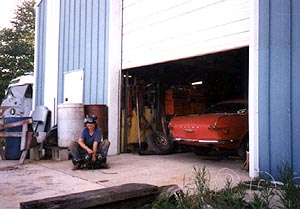 Friday of the SVRA (Sportscar Vintage Racing Association) race weekend at Road America dawned rainy and stayed that way for most of the day. This put a damper on the idea of going to the races. Since David wasn't racing that weekend (which seemed too bad, since he does well on a wet track), we had no great desire to stand around in the rain. Instead, we stayed at OJR for most of Friday.
Friday of the SVRA (Sportscar Vintage Racing Association) race weekend at Road America dawned rainy and stayed that way for most of the day. This put a damper on the idea of going to the races. Since David wasn't racing that weekend (which seemed too bad, since he does well on a wet track), we had no great desire to stand around in the rain. Instead, we stayed at OJR for most of Friday.
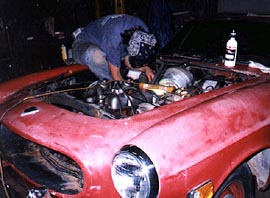 Even though I knew better, in my enthusiasm, I hadn't really taken into account all the little things that somehow end up taking longer than anticipated. Frozen exhaust studs and the like are very time consuming. It was lucky for me that David was there to answer questions and bail me out when I ran into those unanticipated problems. I had been sure that the job would be a piece of cake, back when Robin and I were first discussing the project, despite the fact that this was my first 1800 engine swap.
Even though I knew better, in my enthusiasm, I hadn't really taken into account all the little things that somehow end up taking longer than anticipated. Frozen exhaust studs and the like are very time consuming. It was lucky for me that David was there to answer questions and bail me out when I ran into those unanticipated problems. I had been sure that the job would be a piece of cake, back when Robin and I were first discussing the project, despite the fact that this was my first 1800 engine swap.
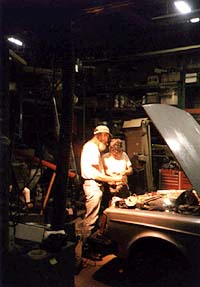 We ran the power directly from the alternator so that the relays fit nicely on the right inner fender. It was late when we finished, but we took a drive so I could see what I had been missing. The change was unbelievable! Once I hit the road, I could hardly wait for nightfall so I could enjoy my new take on night driving.
We ran the power directly from the alternator so that the relays fit nicely on the right inner fender. It was late when we finished, but we took a drive so I could see what I had been missing. The change was unbelievable! Once I hit the road, I could hardly wait for nightfall so I could enjoy my new take on night driving.
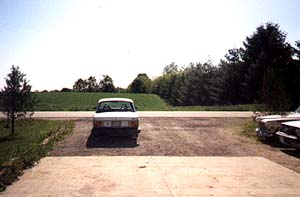 My switch (at David's suggestion) to Castrol 20-50 motor oil for summer driving had reduced my oil consumption almost in half and my new headlamps made night driving a pleasure.
My switch (at David's suggestion) to Castrol 20-50 motor oil for summer driving had reduced my oil consumption almost in half and my new headlamps made night driving a pleasure.